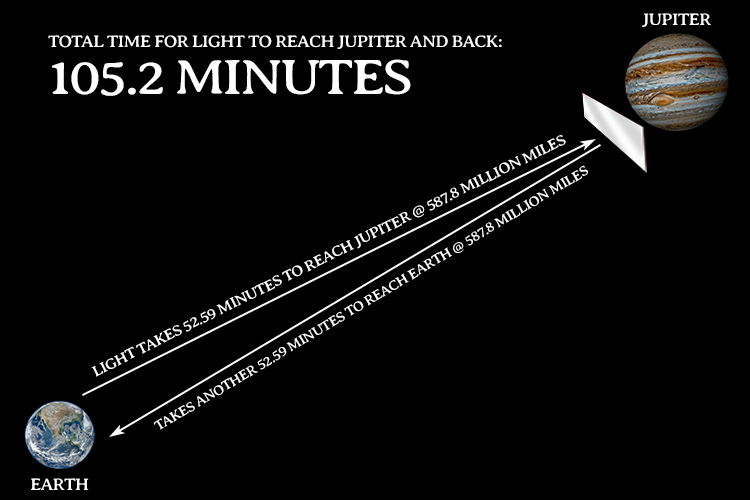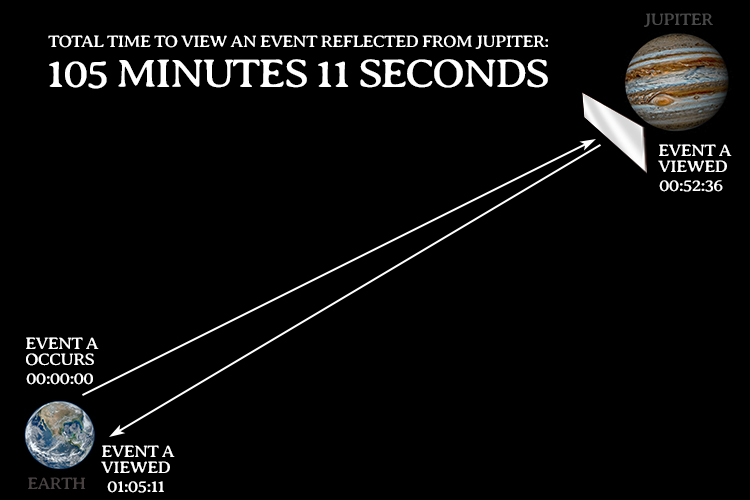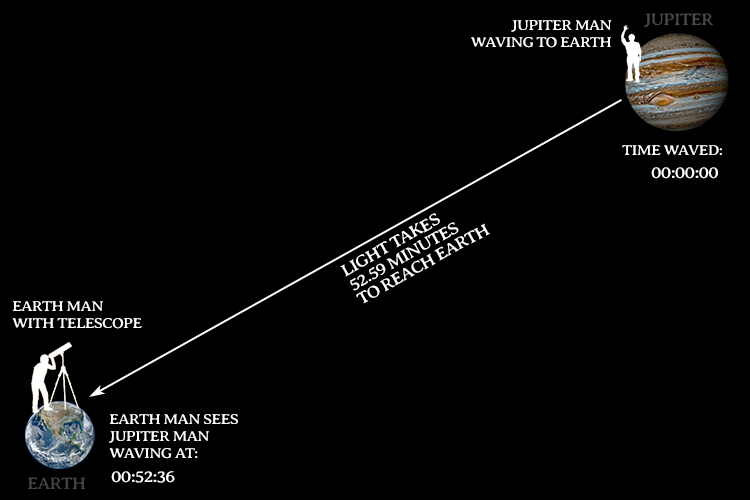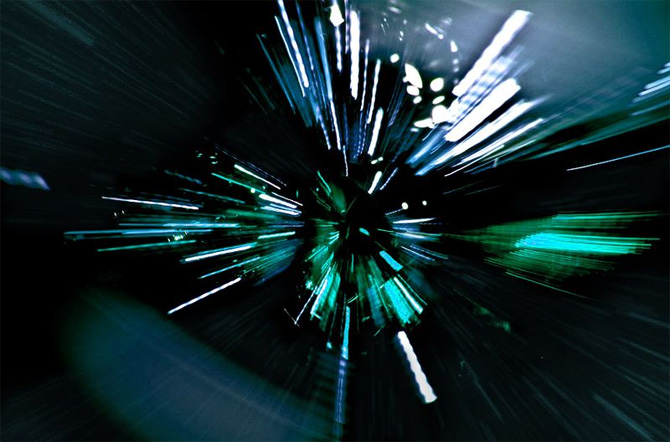I thought of this a few years ago, although only now do I realize how it would be actually possible to implement. Back then I thought, if there was a glint of reflection of light, we could see into our own past. I’m jumping ahead of myself.
Some years ago, I wrote this down:
When we look out at the known universe, we are looking out into the past, essentially time-traveling into the past. The greater we build our telescopes, the further we see into the past. Telescopes are not devices to look into the universe – telescopes are time machines.
Given this, if one were to discover some reflection of light off the universe, or some abstract remnant of light, one would be able to gaze into the past of the Earth itself. Think about it like this: If you were, at this moment, standing on the surface of Alpha Centauri, and you gazed off into space upon Earth, what you would see is not Earth as it is today, but you would be gazing upon Earth as it was 4 years ago, since Alpha Centauri is 4 light-years away.
If there were some way to exploit this, some cosmic remnant of visible light, then scientists could literally look back in time.
I never expected a response, but over the years I’ve thought about this a number of times. Then just now I realized we could actually implement this to methodically see into the past.
The answer? Mirrors. Put some sort of mirror 1 lightyear away. Now look into that mirror with a telescope, and you will literally be looking two years into the past.
This may sound funny, but it is science.
We could prove someone is not guilty (or is guilty) by looking into the “time machine telescope”. This would obviously be limited by physical obstructions and the location of the Earth’s rotation (time of day); i.e. indoors it would not work, and when the Earth is facing the other way it would also not work.
However, you could put an array of these mirrors at different points in space; i.e. a mirror at 1.5 light-years = 3 years into the past, and a mirror at 0.5 light years = 1 year into the past; etc.
Due to the current limitations on travel speed, it would take awhile for this to be tested for greater time frames; but for the short-term, you could put one just .0001 light-years away (587,849,981 miles) and see: approximately 105.2 minutes into the past.
The math:
1 light-year = 5,878,000,000,000 miles.
For light to travel 1 light-year takes one year.
If you look one light-year away, you are looking into the past one year.
.0001 light-years = 587,849,981 miles.
1 year * .0001 = 52.5949 minutes
52.5949 * 2 = 105.1898 minutes
Here’s a diagram to make it easier to understand:


Considering that Jupiter at its farthest is 601 million miles away, and that we have sent exploration spaceships much farther than Jupiter, then such a thing is entirely feasible. Or, to look only about 10 minutes into the past we would only need to place the mirror just .00001 light-years away (58,784,998 miles).
Mars at its farthest is 54.8 million miles, so the mirror would only have to be a little farther than Mars in order to view 10 minutes into the past.
The only obvious limitation is the resolution of the telescope. However, unless I understood this incorrectly, it appears that as of 2015 the Hubble telescope can see the equivalent of a grain of sand as far as 10 million light-years away {
Source} – far more than enough needed.
If this current resolution capability is correct, then we currently have the technology to view the past, in real-time. We could potentially view a live video stream of the past. Obviously, with this method the future would not be possible to view, since current science does not support such a thing. Additionally, actual time travel where you could physically go back in time would also not be possible. I won’t even get into why it’s not possible. However, watching a live stream of the past is completely and entirely possible. We already can watch the past; in fact, I wrote this post in the past yet you are viewing it now. Of course, that’s another level of thinking, but viewing a live feed of the past is not much of a stretch from viewing a video recorded in the past. In fact, the principle is very similar – although, completely different.
Remember, every time you look into the night sky, you are looking into the past. My idea is only taking that science and utilizing it in a practical manner. Using a mirror, you’re just bending the light backward to yourself. It’s kind of like throwing a boomerang.
Think about it like this, if you’re having a hard time wrapping your mind around looking into the past:
If there was a person standing on Jupiter and that person waved at you, and you were looking at them through a telescope, you would not see them wave until about 52 minutes later, because it takes that long for light to travel from Jupiter to Earth.
See the following illustration to help you understand:

If this is still too difficult to wrap your head around, then consider this:
Since sound travels significantly slower than light, when you hear thunder from a distance it is delayed by some time after lightning, usually a few seconds. However, lightning and thunder occur at the same time. In fact, you are hearing back in time a few seconds. That thunder did not just occur, but it occurred a few seconds ago. It took some time for that thunder to reach your ears.
Well, the principle of light delay works the same way. Light travels very fast, so anything that happens here on Earth is seen virtually instantaneously. In other words, there is basically no time-lag from an event that occurs on Earth. However, events that occur in space have a considerable time lag when viewed from Earth. This is because the distance is great enough that light cannot travel fast enough to reach the viewer on Earth immediately upon happening. Thus, all events that you see in space have already happened. You are seeing the past. The farther away the event, the longer it takes to reach you, and thus the farther into the past you are seeing.
I hope that helps you understand it a bit. So let’s discuss more about how this would work:
Additionally, you could use an interstellar positioning system in order to ensure that the mirror was at all times pointed in the correct direction. It would however be difficult to fix it in space at a certain point for a live video feed; however this is merely a matter of logistics. You could also use current existing systems to ensure the telescope is pointed toward the mirror at all times.
The only real aversion I see that could prevent this from happening, is privacy advocates (myself included). Could you imagine the legal implications? It would be a serious violation of privacy. On the other hand, satellites themselves and GPS could also be called a violation of privacy. As it is, GPS is accepted, as are space cams viewing the earth even in the greatest resolution. Perhaps it has to do with the old adage, “out of sight, out of mind”. We don’t see the satellites, so we don’t think about them.
100 years from now I could imagine there being a website where people could view what happened last week, in real-time. Yes, the past in real-time. It would be no less accepted than satellites and mars rovers are accepted today. Although it may be a stretch of the imagination, this is by far no fiction; this isn’t even science fiction. This is cold hard science, as valid as quantum theory or nuclear propulsion.
However, I doubt this will be developed anytime soon – probably not within our lifetime. Not because it can’t, but for the same reason everyone on Earth isn’t driving electric cars yet – money and politics. It’s certainly interesting to think about though.
Nothing like this post has ever been published in all of history. You are reading something that is not in any science or history books. You’re actually reading new science, perhaps the science of the future. No one has done this in any novels, or movies, or anywhere. You are the first people to ever read this. I hope you enjoyed this post.








So are you saying that you thought of this in 2011, but it didn’t reach the Internet till 2015? Same concept?
Great article. How would we alter the thinking to see into the future?
Hi Bob, unfortunately, it’s simply not possible to alter this thinking to see into the future. Not with current science at least.